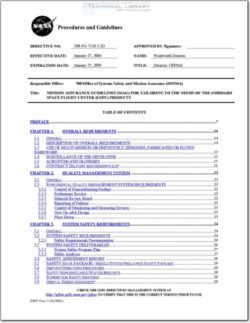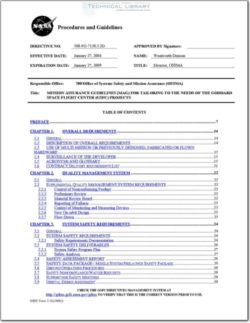NASA-300-PG-7120-2-2D

- Version
- 220 Downloads
- 1.25 MB File Size
- 1 File Count
- May 14, 2016 Create Date
- May 14, 2016 Last Updated
Mission Assurance Guidelines (MAG) for Tailoring to the Needs of the Goddard Space Flight Center(GSFC) Projects.

P.1 PURPOSE
The purpose of this document is to serve as a resource to the Project Manager and OSSMA, in conjunction with 300-
PG-7120.2.1, “Mission Assurance Guidelines (MAG) Implementation”, in supporting the development of a realistic
set of mission assurance requirements tailored to specific needs of an individual project. It is assumed that the
project will select, tailor and then place the appropriate mission assurance requirements either directly into the
contract SOW, and/or within a stand-alone Mission Assurance Requirements document.
P.2 APPLICABILITY
The guidelines of this PG are intended for multiple missions and multiple instruments including Commercial Off-
The-Shelf (COTS) items and apply to in-house, contracts, service level agreements and general support, all of which
will be referred to as the developer.
To the extent referenced herein, applicable portions of the documents listed in Chapter 15 form a part of this
document.
Audit: A review of the developer’s or sub-developer’s documentation or hardware to verify that it complies with
project requirements.
Collected Volatile Condensable Material (CVCM): The quantity of outgassed matter from a test specimen that
condenses on a collector maintained at a specific constant temperature for a specified time.
Component: See Level of Assembly.
Configuration: The functional and physical characteristics of the payload and all its integral parts, assemblies and
systems that are capable of fulfilling the fit, form and functional requirements defined by performance specifications
and engineering drawings.
Configuration Control: The systematic evaluation, coordination, and formal approval/disapproval of proposed
changes and implementation of all approved changes to the design and production of an item the configuration of
which has been formally approved by the developer or by the purchaser, or both.
Configuration Management: The systematic control and evaluation of all changes to baseline documentation and
subsequent changes to that documentation which define the original scope of effort to be accomplished (contract and
reference documentation) and the systematic control, identification, status accounting and verification of all
configuration items.
Contamination: The presence of materials of molecular or particulate nature, which degrade the performance of
hardware.
Derating: The reduction of the applied load (or rating) of a device to improve reliability or to permit operation at
high ambient temperatures.
Design Specification: Generic designation for a specification that describes functional and physical requirements
for an article, usually at the component level or higher levels of assembly. In its initial form, the design
specification is a statement of functional requirements with only general coverage of physical and test requirements.
The design specification evolves through the project lifecycle to reflect progressive refinements in performance,
design, configuration, and test requirements. In many projects the end-item specifications serve all the purposes of
design specifications for the contract end-items. Design specifications provide the basis for technical and
engineering management control.
Designated Representative: An individual (such as a NASA plant representative), firm (such as assessment
developer), Department of Defense (DOD) plant representative, or other government representative designated and
authorized by NASA to perform a specific function for NASA. As related to the developer’s effort, this may include
evaluation, assessment, design review, participation, and review/approval of certain documents or actions.
Destructive Physical Analysis (DPA): An internal destructive examination of a finished part or device to assess
design, workmanship, assembly, and any other processing associated with fabrication of the part.
Design Qualification Tests: Tests intended to demonstrate that the test item will function within performance
specifications under simulated conditions more severe than those expected from ground handling, launch, and
orbital operations. Their purpose is to uncover deficiencies in design and method of manufacture. They are not
intended to exceed design safety margins or to introduce unrealistic modes of failure. The design qualification tests
may be to either “prototype” or “protoflight” test levels.
Discrepancy: See Nonconformance.
| File | Action |
|---|---|
| NASA-300-PG-7120-2-2D Mission Assurance Guidelines (MAG) for Tailoring to the Needs of the Goddard Space Flight Center(GSFC) Projects.pdf | Download |

Comment On This Post